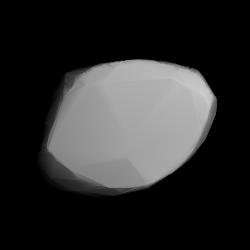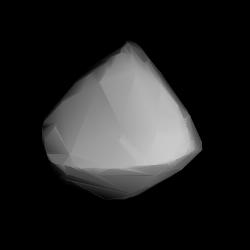Related Research Articles
2934 Aristophanes, provisional designation 4006 P-L, is a carbonaceous Veritasian asteroid from the outer regions of the asteroid belt, approximately 22 kilometers in diameter. It was discovered during the Palomar–Leiden survey in 1960, and later named after ancient Greek dramatist Aristophanes.
4659 Roddenberry, provisional designation 1981 EP20, is a Nysian asteroid from the inner regions of the asteroid belt, approximately 3.6 kilometers (2.2 miles) in diameter. It was discovered on 2 March 1981, by American astronomer Schelte Bus at the Siding Spring Observatory in Australia. The likely S-type asteroid has an unsecured rotation period of 12 hours. It was named for American screenwriter Gene Roddenberry.
2159 Kukkamäki, provisional designation 1941 UX, is a stony asteroid from the inner region of the asteroid belt, approximately 11 kilometers in diameter. It was discovered on 16 October 1941, by Finnish astronomer Liisi Oterma at Turku Observatory in Southwest Finland. It was later named after Finnish geodesist Tauno Kukkamäki.

1743 Schmidt, provisional designation 4109 P-L, is a dark background asteroid from the inner regions of the asteroid belt, approximately 19 kilometers in diameter. It was discovered during the Palomar–Leiden survey on 24 September 1960, by astronomers Ingrid and Cornelis van Houten at Leiden, on photographic plates taken by Tom Gehrels at Palomar Observatory in California. The C-type asteroid has a rotation period of 17.5 hours. It was named for the optician Bernhard Schmidt.
2023 Asaph, provisional designation 1952 SA, is a dark asteroid from the outer regions of the asteroid belt, approximately 21 kilometers in diameter. It was discovered on 16 September 1952, by astronomers of the Indiana Asteroid Program at Goethe Link Observatory in Indiana, United States.
1024 Hale, provisional designation A923 YO13, is a carbonaceous background asteroid from the outer regions of the asteroid belt, approximately 45 kilometers (28 miles) in diameter. The asteroid was discovered on 2 December 1923, by Belgian–American astronomer George Van Biesbroeck at the Yerkes Observatory in Wisconsin, United States. It was named for American astronomer George Ellery Hale. The dark C-type asteroid may have a rotation period of 16 hours.
6433 Enya, provisional designation 1978 WC, is a stony background asteroid from the inner regions of the asteroid belt, approximately 7 kilometers in diameter. It was discovered on 18 November 1978, by Czech astronomer Antonín Mrkos at the Kleť Observatory in the Czech Republic. It was named for Irish musician Enya.
12359 Cajigal, provisional designation 1993 SN3, is a carbonaceous Themistian asteroid from the outer region of the asteroid belt, approximately 12 kilometers in diameter.

9994 Grotius, provisional designation 4028 P-L, is a stony Rafita asteroid from the middle regions of the asteroid belt, approximately 3.5 kilometers in diameter. It was discovered during the Palomar–Leiden survey in 1960, and named after Dutch jurist Hugo Grotius.

9936 Al-Biruni, provisional designation 1986 PN4, is a carbonaceous asteroid from the outer region of the asteroid belt, approximately 24 kilometers in diameter. It was discovered on 8 August 1986, by Belgian and Bulgarian astronomers Eric Elst and Violeta Ivanova at the Rozhen Observatory, located in Bulgaria's Smolyan province near the border to Greece. It was named for Persian medieval scholar Al-Biruni.
3277 Aaronson, provisional designation 1984 AF1, is a carbonaceous asteroid from the outer region of the asteroid belt, approximately 20 kilometers in diameter. It was discovered by American astronomer Edward Bowell at Lowell's Anderson Mesa Station, near Flagstaff, Arizona, on 8 January 1984, and named in memory of astronomer Marc Aaronson.
9549 Akplatonov, provisional designation 1985 SM2, is an Eunomia asteroid from the central region of the asteroid belt, approximately 8.2 kilometers (5.1 miles) in diameter. It was discovered on 19 September 1985, by Soviet–Russian astronomer couple Nikolai and Lyudmila Chernykh at the Crimean Astrophysical Observatory in Nauchnyj, on the Crimean peninsula. The likely S-type asteroid has a relatively short rotation period of 2.8 hours. It was named for Russian computational mathematician Aleksandr Platonov.
2939 Coconino, provisional designation 1982 DP, is a stony Nysian asteroid from the inner regions of the asteroid belt, approximately 6 kilometers in diameter. It was discovered on 21 February 1982, by American astronomer Edward Bowell at Lowell's Anderson Mesa Station in Flagstaff, United States. It is named after the Coconino County in Arizona.

5635 Cole (prov. designation: 1981 ER5) is a background asteroid from the inner regions of the asteroid belt, approximately 4 kilometers (2.5 miles) in diameter. It was discovered on 2 March 1981, by American astronomer Schelte Bus at the Siding Spring Observatory in Australia. The L/S-type asteroid has a rotation period of 5.79 hours. It was named after the fictional character Joshua Cole.
3936 Elst, provisional designation 2321 T-3, is a stony Vestian asteroid from the inner regions of the asteroid belt, approximately 5 kilometers in diameter. The asteroid was discovered on 16 October 1977, by Dutch astronomer couple Ingrid and Cornelis van Houten at Leiden, on photographic plates taken by Dutch–American astronomer Tom Gehrels at Palomar Observatory in California, United States. It was named after Belgian astronomer Eric W. Elst.
1267 Geertruida, provisional designation 1930 HD, is a carbonaceous background asteroid from the inner regions of the asteroid belt, approximately 20 kilometers in diameter. Discovered by astronomer Hendrik van Gent at Johannesburg Observatory in 1930, the asteroid was later named after Geertruid Pels, sister of Dutch astronomer Gerrit Pels.
3099 Hergenrother, provisional designation 1940 GF, is an asteroid from the outer region of the asteroid belt, approximately 15 kilometers in diameter. It was discovered on 3 April 1940, by Finnish astronomer Yrjö Väisälä at Turku Observatory in Southwest Finland, and named after American astronomer Carl Hergenrother in 1996.
3823 Yorii, provisional designation 1988 EC1, is a carbonaceous asteroid from the outer region of the asteroid belt, approximately 11 kilometers in diameter.
6181 Bobweber, provisional designation 1986 RW, is a stony asteroid from the inner regions of the asteroid belt, approximately 5 kilometers in diameter. It was discovered on 6 September 1986, by American astronomer Eleanor Helin at the U.S. Palomar Observatory in California, and named after astronomer Robert Weber.
9524 O'Rourke, provisionally designated 1981 EJ5, is an asteroid from the inner regions of the asteroid belt, approximately 3 kilometers in diameter. It was discovered on 2 March 1981, by American astronomer Schelte Bus at the Siding Spring Observatory in New South Wales, Australia. The asteroid was named after Laurence O'Rourke, a researcher at the European Space Astronomy Centre.
References
- 1 2 3 4 5 6 7 "4432 McGraw-Hill (1981 ER22)". Minor Planet Center. Retrieved 27 May 2018.
- 1 2 3 4 5 "JPL Small-Body Database Browser: 4432 McGraw-Hill (1981 ER22)" (2018-04-23 last obs.). Jet Propulsion Laboratory . Retrieved 27 May 2018.
- 1 2 3 4 5 6 7 8 "LCDB Data for (4432) McGraw-Hill". Asteroid Lightcurve Database (LCDB). Retrieved 27 May 2018.
- 1 2 "Asteroid 4432 McGraw-Hill". Small Bodies Data Ferret. Retrieved 27 May 2018.
- 1 2 3 Masiero, Joseph R.; Mainzer, A. K.; Grav, T.; Bauer, J. M.; Cutri, R. M.; Dailey, J.; et al. (November 2011). "Main Belt Asteroids with WISE/NEOWISE. I. Preliminary Albedos and Diameters". The Astrophysical Journal. 741 (2): 20. arXiv: 1109.4096 . Bibcode:2011ApJ...741...68M. doi:10.1088/0004-637X/741/2/68. S2CID 118745497.
- 1 2 3 4 Mainzer, A.; Grav, T.; Masiero, J.; Hand, E.; Bauer, J.; Tholen, D.; et al. (November 2011). "NEOWISE Studies of Spectrophotometrically Classified Asteroids: Preliminary Results". The Astrophysical Journal. 741 (2): 25. arXiv: 1109.6407 . Bibcode:2011ApJ...741...90M. doi:10.1088/0004-637X/741/2/90. S2CID 35447010. (catalog)
- 1 2 3 Binzel, Richard P.; Xu, Shui; Bus, Schelte J.; Bowell, Edward (September 1992). "Small Main-Belt Asteroid Lightcurve Survey". Icarus. 99 (1): 225–237. Bibcode:1992Icar...99..225B. doi:10.1016/0019-1035(92)90184-9. ISSN 0019-1035.
- ↑ "MPC/MPO/MPS Archive". Minor Planet Center. Retrieved 27 May 2018.